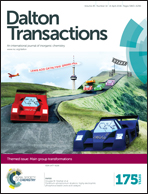The first examples of 1-D organic hybrid lanthanoid thioarsenates based on two [AsVS4]3− linkage modes†
Abstract
A series of new 1-D organic hybrid lanthanoid thioarsenates [Ln(dap)2]2(μ–η1:η1:η1:η1-AsS4)(μ–η1:η1-AsVS4)]n {Ln = Ce (Ia), Pr (Ib), Nd (Ic), and Sm (Id); dap = diaminopropane} have been prepared under solvothermal conditions and structurally characterized. Compounds Ia–d contain two [AsVS4]3− linkage modes, namely μ–η1:η1:η1:η1-AsVS4 and μ–η1:η1-AsVS4, which are linked alternately with [Ln(dap)2]3+ groups into 1-D neutral chains [Ln(dap)2]2(μ–η1:η1:η1:η1-AsVS4)(μ–η1:η1-AsVS4)]n, which represent the first examples of 1-D organic hybrid lanthanoid thioarsenates based on two [AsVS4]3− linkage modes. To learn more about the influence of lanthanide contraction on the formation of lanthanoid thioarsenates, five organic hybrid lanthanoid thioarsenates [Ln(dap)3AsVS4] [Ln = Tb (IIa), Dy (IIb), Ho (IIIc), and Er (IIId)] and [Er(dien)2AsVS4] (III, dien = diethylenetriamine) are also provided. Both II and III contain neutral lanthanide-centred complexes, where the tetrahedral anion [AsVS4]3− acts as a chelating ligand to the complex [Ln(dap)3]3+/[Er(dien)2]3+ cation. Their optical properties have been characterized by UV-vis spectra, and the density functional theory calculation of Ia has been performed.
![Graphical abstract: The first examples of 1-D organic hybrid lanthanoid thioarsenates based on two [AsVS4]3− linkage modes](/en/Image/Get?imageInfo.ImageType=GA&imageInfo.ImageIdentifier.ManuscriptID=C5DT02188J&imageInfo.ImageIdentifier.Year=2016)
- This article is part of the themed collection: Main Group Transformations

 Please wait while we load your content...
Please wait while we load your content...